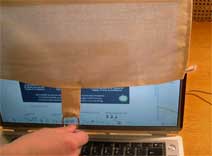Snip
|
Talking about slowing the web:
|
|---|
Categories |
|
|---|
For Snip |
loading snip actions ... |
|---|---|
For Page |
loading url actions ... |
Talking about slowing the web:
Louise Klinker's SLOWEB project that responds to peoples' obsession with speed and efficiency when using computers.
What does it mean when you have to queue to enter a website? And does it feel special to know that you are the only one using a service like Google at that time?


SLOWEB offers peripherals for the computer: a blind for the screen and a coffee mug to use as a mouse. SLOWEB also offers two computer applications: a special slow mail service that provides extra information about how long the author took to write it and is also concerned with the geographical relationship between author and receiver and a unique version of Google that requires you to queue if you want to enter a website.
And there's also SLOWmail by Carolyn Strauss and Julian Bleecker from slowLab. This project has been awarded one of the Rhizome 2006/2007 commissions. The email service would deliberately slow down the pace of electronic messaging, offering a more reflective experience for both sender and recipient, and challenging forth more artful, writerly and meaning-ful correspondence.
The author tags his correspondence to describe a relationship to the recipient, their respective geographic locations and the mood of the message. The message is then filtered through the SLOWmail software environment which further interprets its meaning and assesses the sender-recipient relationship, factoring in message history, frequency of correspondence and past message content to determine the delivery timeframe.
At any time, users may login to the SLOWmail web site to view messages in progress, experienced as compelling graphic visualizations that develop gradually to represent pending correspondence.
HTML |
<p><strong>Talking about slowing the web</strong>:</p> <p>Louise Klinker's <a href="http://www.lwk.dk/sloweb/new%20edition/sloweb_Frameset.htm">SLOWEB</a> project that responds to peoples' obsession with speed and efficiency when using computers.</p> <p>What does it mean when you have to queue to enter a website? And does it feel special to know that you are the only one using a service like Google at that time?</p> <p><img alt="0slowbaini.jpg" src="http://www.we-make-money-not-art.com/yyy/0slowbaini.jpg" height="156" width="210"> <img alt="0snail9.jpg" src="http://www.we-make-money-not-art.com/yyy/0snail9.jpg" height="156" width="212"></p> <p>SLOWEB offers peripherals for the computer: a <a href="http://www.lwk.dk/sloweb/new%20edition/slides/blind_slide1.htm">blind for the screen</a> and a <a href="http://www.we-make-money-not-art.com/archives/006490.php">coffee mug to use as a mouse</a>. SLOWEB also offers two computer applications: a special slow mail service that provides extra information about how long the author took to write it and is also concerned with the geographical relationship between author and receiver and a <a href="http://www.lwk.dk/sloweb/new%20edition/slides/google_slide1.htm">unique version of Google</a> that requires you to queue if you want to enter a website. </p> <p>And there's also <a href="http://www.slowlab.net/slowmail.html">SLOWmail</a> by <a href="http://www.slowlab.net/">Carolyn Strauss</a> and <a href="http://www.techkwondo.com/">Julian Bleecker</a> from <a href="http://www.slowlab.net/">slowLab</a>. This <a href="http://rhizome.org/commissions/2006/slowlab.rhiz">project</a> has been awarded one of the <a href="http://rhizome.org/commissions/2006.rhiz">Rhizome 2006/2007 commissions.</a> The email service would deliberately slow down the pace of electronic messaging, <em>offering a more reflective experience for both sender and recipient, and challenging forth more artful, writerly and meaning-ful correspondence</em>. </p> <p>The author tags his correspondence to describe a relationship to the recipient, their respective geographic locations and the mood of the message. The message is then filtered through the SLOWmail software environment which further interprets its meaning and assesses the sender-recipient relationship, factoring in message history, frequency of correspondence and past message content to determine the delivery timeframe.</p> <p>At any time, users may login to the SLOWmail web site to view messages in progress, experienced as compelling graphic visualizations that develop gradually to represent pending correspondence. </p> |
|---|